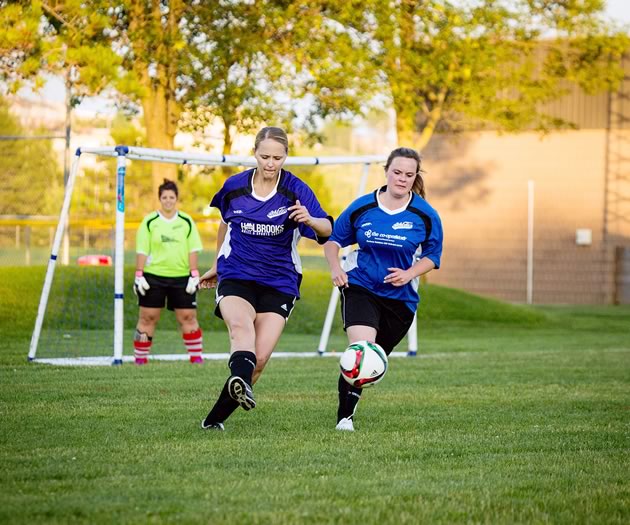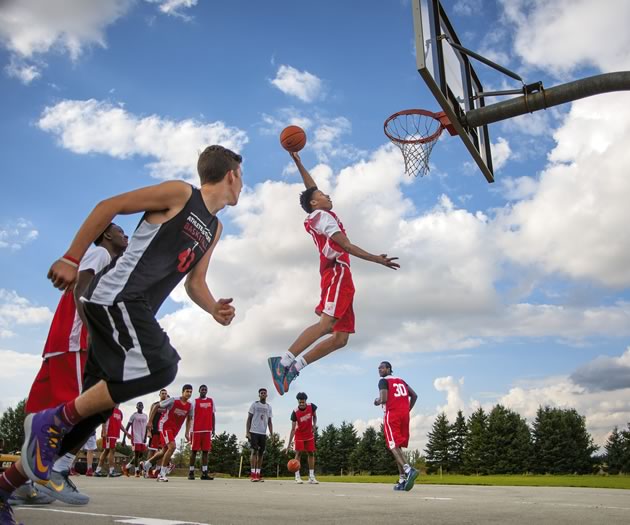The Good Old Soccer Game
Leaving hockey behind, sports lovers in the hills and beyond are heading to the soccer pitch in record numbers.
With the Raptors’ playoff efforts making team history this year, the Blue Jays’ stellar season last year, and the Maple Leafs being, well, the Maple Leafs, sports talk has focused on hockey’s waning popularity. It’s too expensive. It doesn’t resonate with new Canadians. Concussions are rife…

Caledon’s Ashley Lawrence will be competing on the Canadian women’s soccer team in Rio this summer. Photo by Erin Fitzgibbon.
Hovering just outside the spotlight in Canada – and in Headwaters – is soccer. According to the Department of Canadian Heritage, 42 per cent of five- to 14-year-olds who participate in sports play soccer, while only 22 per cent lace up hockey skates; 16 per cent shoot hoops, and even fewer don a baseball glove. We may not know it yet, but Canada is a soccer nation. It’s a fact that will become more evident as millennials tune into Manchester United rather than the Vancouver Canucks.
Consider this: FIFA, world soccer’s governing body, reported in its most recent Big Count that about 8.5 per cent of Italians, for example, played soccer. Canada was not far behind. Nearly 2.7 million Canadians – about 8.2 per cent of the country’s population at the time – got out onto the pitch. And these numbers are growing. Worldwide, the number of soccer players increased by 10 per cent between 2000 and 2006, and women accounted for much of that growth. Though the number of male players rose by 8 per cent, their female counterparts increased their number by 19 per cent.
These goalkeepers, defenders, midfielders and forwards are among the 3.5 billion people – yes, nearly half the population of the planet – who claim to be soccer fans, according to various websites dedicated to tracking such statistics. One in five Germans may play soccer, but it was Canada that set an astounding record in 2015 when it hosted the FIFA Women’s World Cup and 1.35 million spectators filled the seats for the matches. That event set a new attendance record for a FIFA competition other than the men’s World Cup. Yet the Canadian women made it only as far as the quarter-finals, and no matches were played in Toronto, arguably the country’s hottest soccer market.
Given the number of pitches popping up, the fact that minimal equipment – cleats or running shoes, shin guards and a ball – is needed to play, the country’s changing demographics, and the growing popularity and success of the national women’s team, Canada’s soccer future looks as golden as a referee’s jersey.
Caledon East’s Lange family presents a soccer portrait. As kids, the three Lange girls had a choice of playing T-ball or soccer. When all three chose soccer, father Eric became the local league’s treasurer and a coach, and at 40, mother Mary began playing in the women’s pickup league. “At one point,” says Mary, “all five of us played.”
Now in their 20s, both Melissa Lange and her sister Veronica play in the same women’s league that Mary retired from after eight seasons. Moreover, the sisters are co-captains. “It’s come full circle,” says Melissa. “It’s fulfilling a dream.”
The adult soccer league in Caledon is friendly. For the four women’s teams, there is zero tolerance for rough play, though the eight men’s teams are a little more lenient in that regard. In addition, players sign up as individuals and are placed on a team, so all teams are equal. “It about a sense of community,” says Melissa. “There’s no Palgrave versus Caledon East.”
The physical fitness aspect of the game is the most important, says Gisele White, who co-ordinates communications for the Caledon Soccer Club. “Most players pick up soccer skills pretty quickly,” she adds.
“Recreational soccer is catching on over competitive soccer, ” says Keith Robbins, co-ordinator of the Orangeville Athletics Sports and Social Club leagues. Eight teams play in the women’s league, usually on Thursday evenings, at Rotary Park. And on Friday evenings, four squads of adult men take their turn.

Members of the Orangeville Athletic Sports and Social Club women’s league play weekly at Rotary Park throughout the summer. Photo by Erin Fitzgibbon.
In Caledon’s south end, players who want to play competitively have a chance to progress through the Brampton North Soccer Club’s tiered system. The club plays in Caledon at the Brampton Fairgrounds. With the largest indoor pitch around, they attract the best adult players. Club president Diane Sasek insists men’s teams in the top division “would beat the Toronto FCs on any given day.” This indoor, winter-only league attracts 50 teams – 18 women’s and 32 men’s – of 18 players each. Sasek explains they no longer offer adult soccer in the summer because they are overwhelmed by the 2,000 kids who take part on the outdoor pitches at Mayfield Secondary School.
Twenty-one-year-old Ashley Lawrence, a soccer star when she attended Mayfield, still visits her mom in the Village of Southfields in south Caledon. She played on the national women’s team alongside her hero, team captain Christine Sinclair, at that record-breaking World Cup last year, making her practically a veteran on the squad going to Rio this summer.
The attacking midfielder can’t wait to compete there in her first Olympics, but she wasn’t always so excited about international play. “I remember crying,” says Ashley, as she recalls climbing aboard a plane as the youngest member of Canada’s under-17 squad. “I was so scared to go to Trinidad and Tobago, but my parents encouraged me.”
Ashley is the future of soccer in the land of hockey, and not just because she is a team player, has explosive speed and great ball-handling skills. While her father is from Jamaica, her mother is a ninth generation Canadian. “That makes me the tenth generation and I kind of like that,” she says.
Ashley knew soccer was it for her when she was 10. “I loved the feeling of being on the field,” she says.
She made the national under-17 team when she was 14 and the national team at 17, and although she’s taken a break from school to focus on the Olympics, she is set to graduate from West Virginia University in 2017 with a degree in sport and exercise psychology.
For this year, however, soccer is Ashley’s full-time job. She says the team practises soccer skills on the field for about two hours a day, spends three or four hours in the gym, has team meetings and puts in time on mental fitness as well. Leading up to games and training sessions, she uses a computer program that helps her stay focused and calm. “It really helps me maintain energy and stay involved in the game during the slow parts,” she says.
On Livestrong.com, journalist Rogue Parrish writes, “Soccer allows a fair amount of legal contact, although it still falls short of being a collision sport like hockey.” Nonetheless, unlike local adult soccer, the international game Ashley Lawrence plays is a rough one. “You don’t have to be big,” says the five-foot-six-incher with rock-solid quadriceps, “but you have to be strong.”
More Info
Local links for soccer clubs:
Related Stories

Women Shine in Learn-to Sport Programs
Jun 21, 2017 | | Good SportWhat makes the difference? Support and personal connections.

Tennis a Lifelong Sport
Mar 23, 2015 | | Good SportWith nine community clubs and one busy private club, you can find a game anytime, anywhere in Headwaters.

Orangeville Basketball Puts a Small Town on the NBA Map
Mar 21, 2016 | | LeisureWith the top high school basketball program in the country and the NBA taking notice, a local family has made Orangeville the new epicentre of Canadian basketball.

Thon Maker Update
Apr 12, 2016 | | LeisureDispelling some myths around Athlete Institute’s latest NBA draft prospect Thon Maker.










